微服務系列之授權認證(二) identity server 4
1.簡介
IdentityServer4 是為ASP.NET Core系列量身打造的一款基於 OpenID Connect 和 OAuth 2.0 認證授權框架。
官方檔案:https://identityserver4.readthedocs.io/en/latest/
框架原始碼:https://github.com/IdentityServer/IdentityServer4
IdentityServer主要使用場景:
1)基於中臺認證中心的saas系統/pass系統的單點登入或者做為統一認證授權入口(授權模式:授權碼模式Authorization Code或者混合模式hybrid);
2)用於API服務與API服務之間的固定token通訊,或者某業務系統服務群集與其他業務系統的服務群集之間通訊,或者某業務系統群集服務與中臺服務群集之間通訊,所使用的授權模式為使用者端模式Client Credential;
3)用於移動使用者端與API服務之間通訊,授權碼模式為自定義授權碼。
4)用於給第三方使用者端授權使用平臺資料資源,類似微信、支付寶等使用者授權給。主要授權模式為權碼模式Authorization Code
2.Identity Server入門demo
新建.net core 3.1專案,nuget安裝IdentityServer4,我這裡是3.14版本
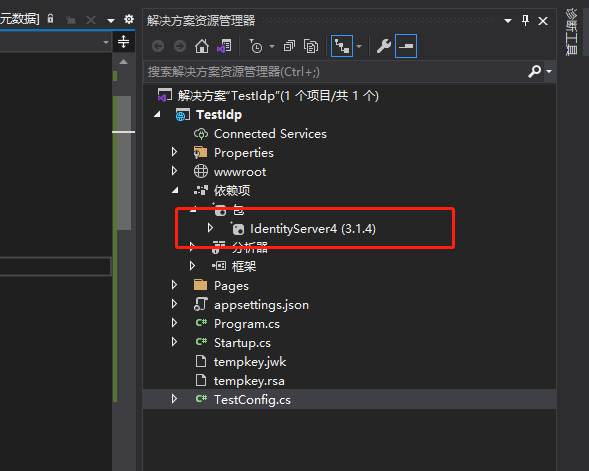
正常來說,商業業務,Api資源、Client使用者端、Identity資源、User等資料儲存在資料庫,token可以儲存在資料庫也可以儲存到redis,這裡為了入門演示,使用記憶體模式,快速搭建。
定義一個類,建立API資源,使用者端client,我們這裡只使用使用者端模式授權,篇幅問題,其他授權方式就不一一寫了,基本都差不多
public class TestConfig
{
/// <summary>
/// Api資源
/// </summary>
/// <returns></returns>
public static IEnumerable<ApiResource> GetApiResources()
{
return new List<ApiResource>
{
new ApiResource(){
Name = "myapi",
ApiSecrets= new List<Secret>(){
new Secret(){
Description = "secret",
Value = "secret".Sha256()
}
},
Scopes = new List<Scope>(){
new Scope(){
Name = "apim"
}
}
},
};
}
/// <summary>
/// client
/// </summary>
/// <returns></returns>
public static IEnumerable<Client> GetClients()
{
return new List<Client>
{
new Client()
{
ClientId="client",//定義使用者端ID
//AllowedGrantTypes = new List<string>()
//{
// GrantTypes.ResourceOwnerPassword.FirstOrDefault(),
// GrantType.ClientCredentials,
// GrantType.Hybrid
//},
//必須是單個指定授權型別,可能是記憶體模式問題。
AllowedGrantTypes = GrantTypes.ClientCredentials,
// 用於認證的密碼
ClientSecrets =
{
new Secret("secret".Sha256())
},
AllowedScopes= {"apim"},
AccessTokenLifetime = 360000000
},
};
}
public static List<TestUser> GetTestUsers()
{
return new List<TestUser>
{
new TestUser()
{
SubjectId = "1",
Username = "test",
Password = "123456"
}
};
}
}
在啟動類注入
public void ConfigureServices(IServiceCollection services)
{
services.AddRazorPages();
#region 記憶體方式
services.AddIdentityServer()
.AddDeveloperSigningCredential()//新增證書加密方式,執行該方法,會先判斷tempkey.rsa證書檔案是否存在,如果不存在的話,就建立一個新的tempkey.rsa證書檔案,如果存在的話,就使用此證書檔案。
.AddInMemoryApiResources(TestConfig.GetApiResources())//把受保護的Api資源新增到記憶體中
.AddInMemoryClients(TestConfig.GetClients())//使用者端設定新增到記憶體中
.AddTestUsers(TestConfig.GetTestUsers())//測試的使用者新增進來
.AddDeveloperSigningCredential();
#endregion
}
public void Configure(IApplicationBuilder app, IWebHostEnvironment env)
{
if (env.IsDevelopment())
{
app.UseDeveloperExceptionPage();
}
else
{
app.UseExceptionHandler("/Error");
}
app.UseStaticFiles();
app.UseRouting();
//新增中介軟體
//這個必須在UseRouting和UseEndpoints中間。如果IdentityServer伺服器端和API端要寫在一起,
//那麼這個必須在UseAuthorization和UseAuthentication的上面。
app.UseIdentityServer();
app.UseAuthorization();
app.UseEndpoints(endpoints =>
{
endpoints.MapRazorPages();
});
}
然後啟動服務,使用postman存取identity server 4預設的endpoint地址發現檔案:
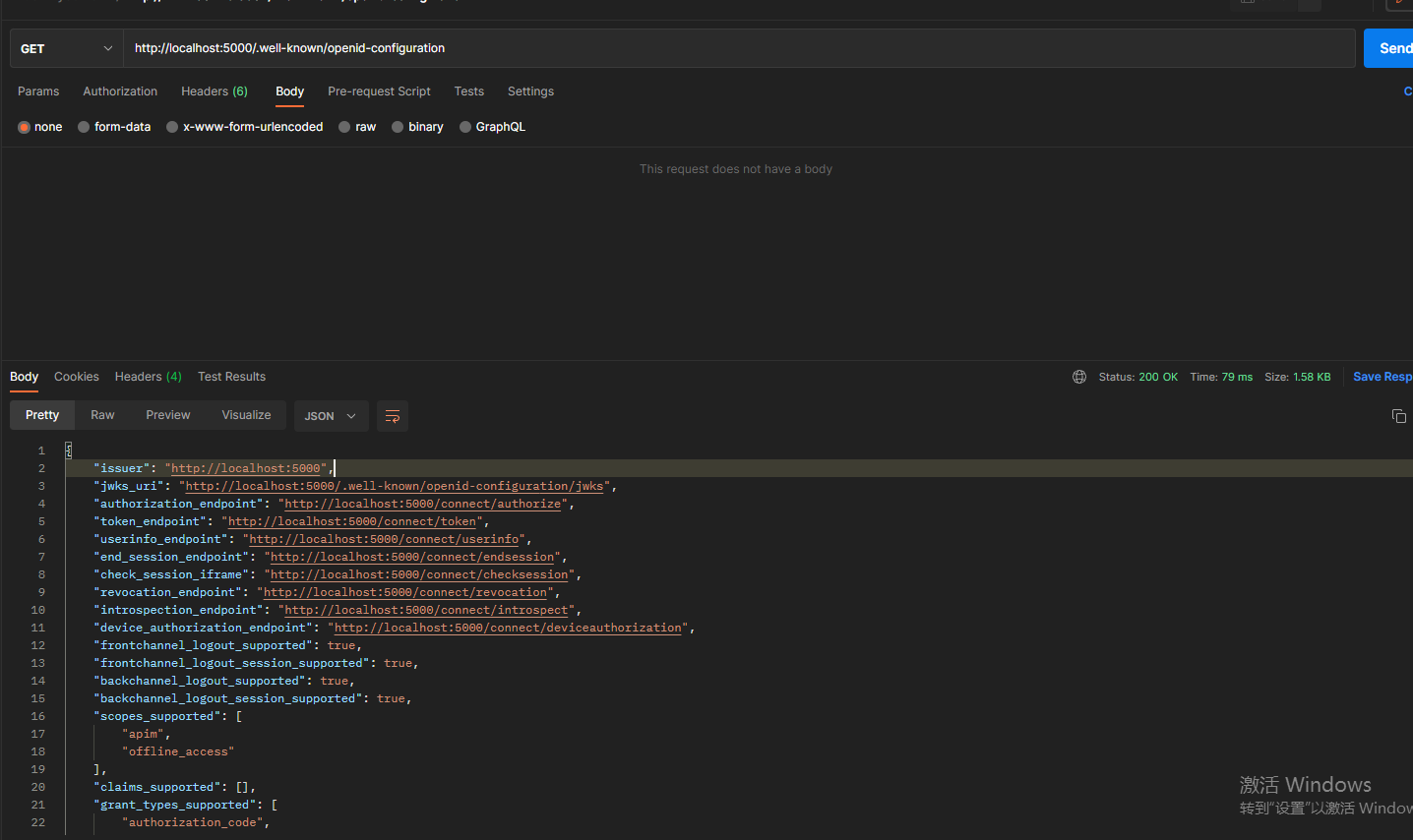
使用identityServer4的發現檔案中的token_endpoint獲取token
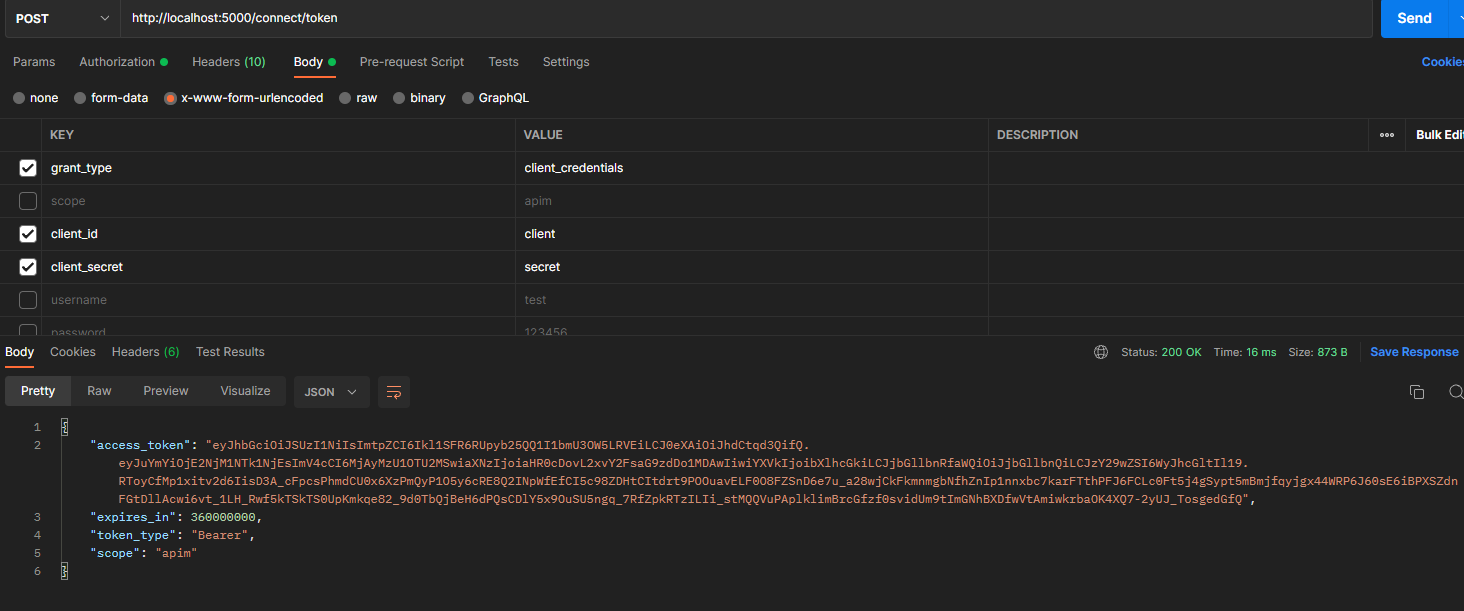
token已經獲取了,可以使用發現檔案裡的introspection_endpoint來驗證token

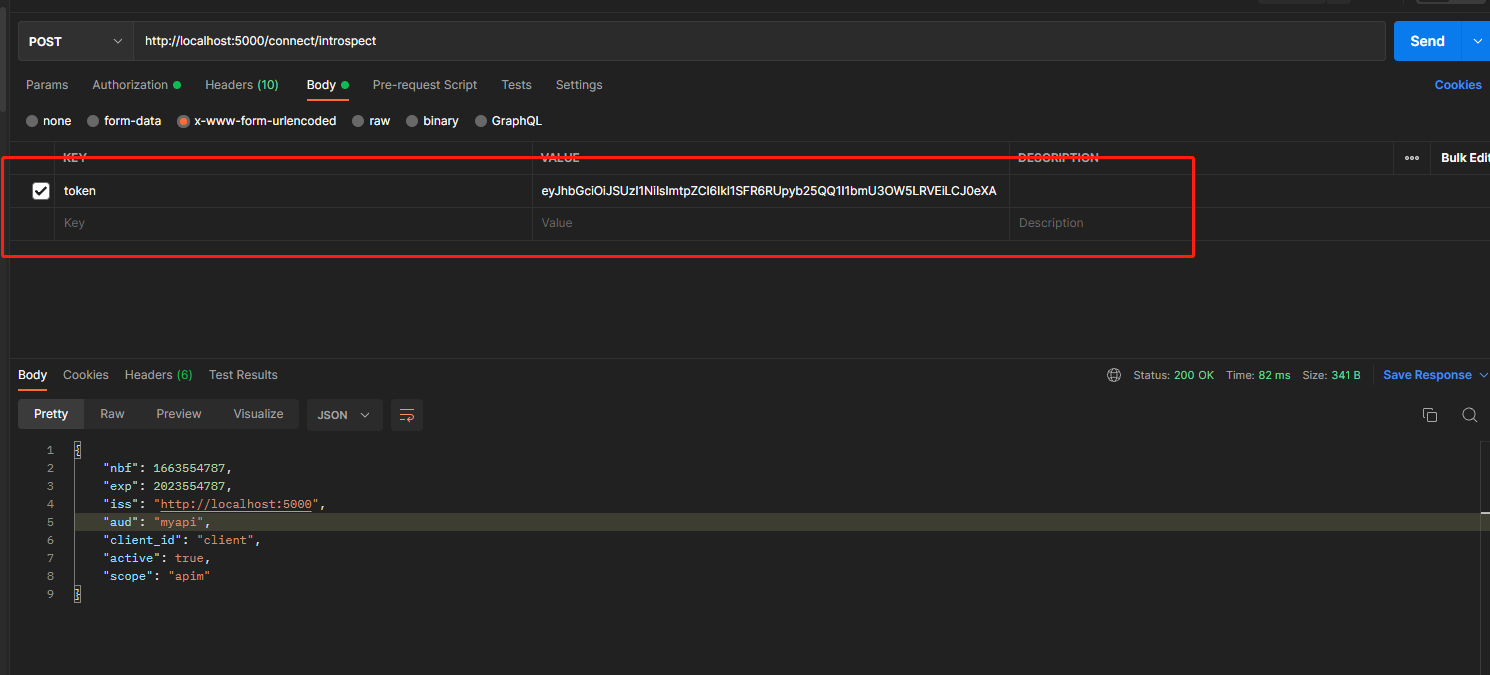
上圖可見,我們已經為client使用者端,建立了一個擁有存取scope為apim許可權的token
接下來,建立一個受保護的api服務,同樣建立一個.net core 3.1服務,並nuget包安裝Microsoft.AspNetCore.Authentication.JwtBearer,選擇3.14版本,根據.net core版本來
在啟動類中,設定認證和授權DI,和新增認證授權中介軟體:
public class Startup
{
// This method gets called by the runtime. Use this method to add services to the container.
// For more information on how to configure your application, visit https://go.microsoft.com/fwlink/?LinkID=398940
readonly string MyAllowSpecificOrigins = "_myAllowSpecificOrigins";
public void ConfigureServices(IServiceCollection services)
{
//設定認證
services.AddAuthentication("Bearer")
.AddJwtBearer(options =>
{
options.Authority = "http://localhost:5000";//剛才啟動的授權認證服務
options.RequireHttpsMetadata = false;
options.TokenValidationParameters = new TokenValidationParameters //不驗證jwt的aud資訊
{
ValidateAudience = false
};
});
// 設定授權策略
services.AddAuthorization(options =>
{
//定義授權策略,這個名字可以隨便起
options.AddPolicy("ApiScope", policy =>
{
policy.RequireAuthenticatedUser();
//
policy.RequireClaim("scope", "apim");//策略需要scope有apim
});
options.AddPolicy("ApiScope2", policy =>
{
policy.RequireAuthenticatedUser();
//
policy.RequireClaim("scope", "apim2");
});
});
services.AddSingleton<IHttpContextAccessor, HttpContextAccessor>();
services
.AddCors(options =>
{
options.AddPolicy(MyAllowSpecificOrigins,
builder => builder.AllowAnyOrigin()
.WithMethods("GET", "POST", "HEAD", "PUT", "DELETE", "OPTIONS")
);
}).AddMvc();
services.AddControllers();
}
// This method gets called by the runtime. Use this method to configure the HTTP request pipeline.
public void Configure(IApplicationBuilder app, IWebHostEnvironment env)
{
if (env.IsDevelopment())
{
app.UseDeveloperExceptionPage();
}
app.Use((context, next) =>
{
context.Request.EnableBuffering();
return next();
});
app.UseRouting();
//跨域設定
app.UseCors(MyAllowSpecificOrigins);
//身份驗證中介軟體 (身份驗證必須在授權的前面)
app.UseAuthentication();
//授權驗證中介軟體
app.UseAuthorization();
app.UseEndpoints(endpoints =>
{
endpoints.MapControllers();
});
app.UseEndpoints(endpoints =>
{
endpoints.MapGet("/", async context =>
{
await context.Response.WriteAsync("Hello World!");
});
});
}
}
寫2個介面
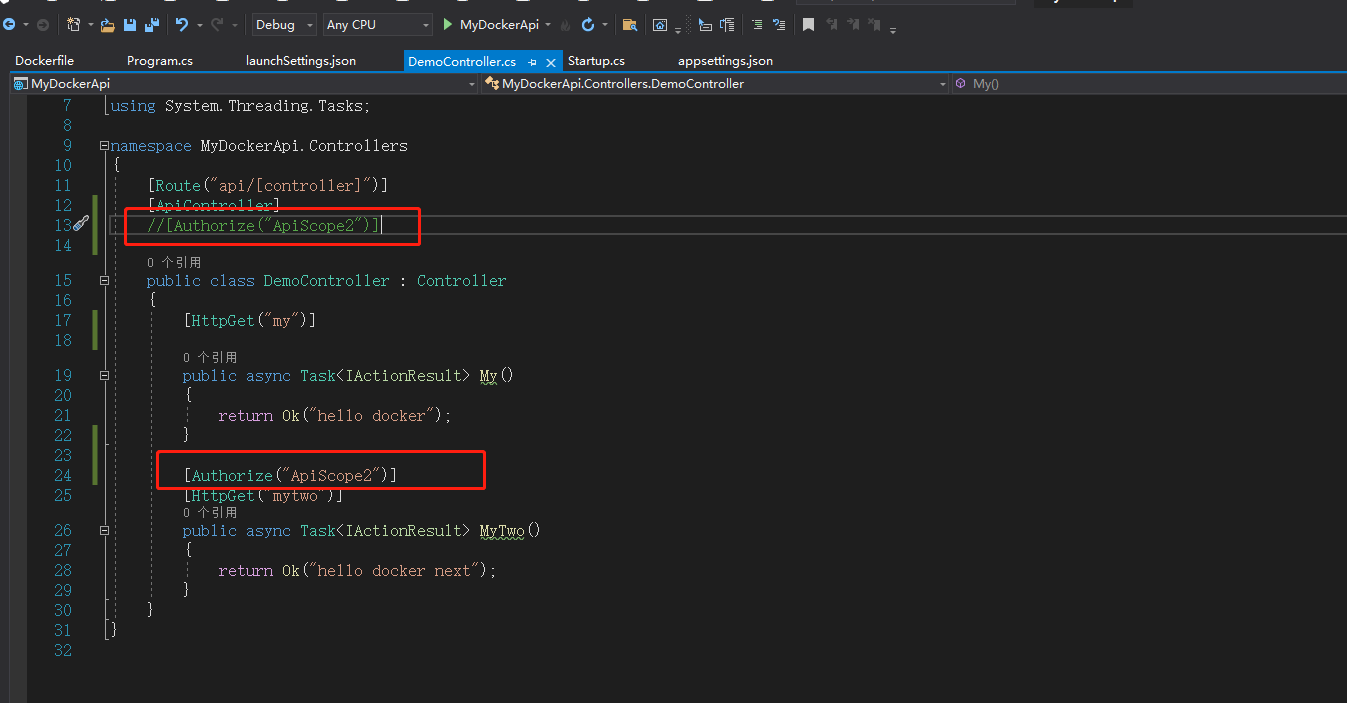
注意,Authorize標籤可生效於類或者方法上,,根據不同的授權策略來合理安排需要保護的資源。最後,可以用剛才的token來存取這個API,,如果token錯誤會401,如果根據授權策略的不同,比如mytwo介面受到apiScope2策略保護,apiScope2策略需要apim2這個scope許可權,因為剛才我們獲取的token只包含apim這個scope許可權,所以存取會返回403許可權不足,大家可以去試試,我試過了就不貼圖。
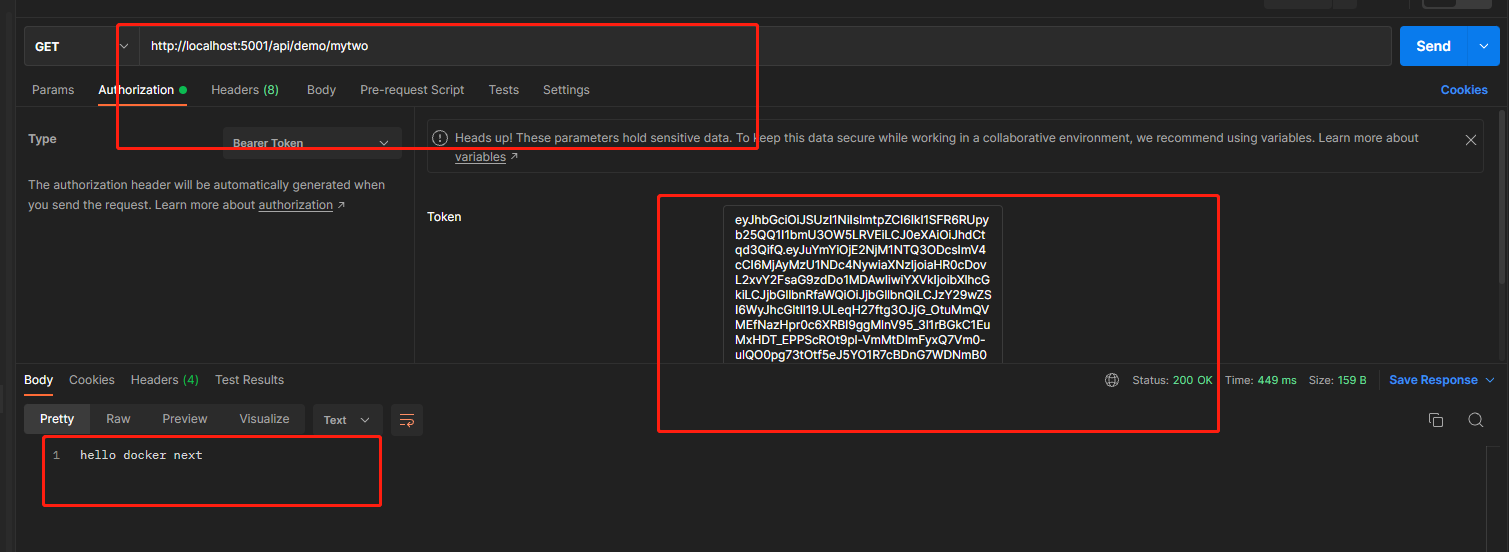
至此demo結束,大家可以去試試其他模式的獲取token方式
3.IdentityServer4的資料儲存
商業級專案,授權資源是需要持久化儲存的,官方已經提供了基於ef core的來維護我們授權資源和token的管理模型、上下文、倉儲介面等,具體我就不寫了,推薦參考這篇文章.net core 3.1 Identity Server4 (EntityFramework Core 設定) - 塵葉心繁的專欄 - TNBLOG。下面貼幾張基於Identity Server4 EFCore包管理的APIResource、Client、Identity資源、Token的相關程式碼簡介
services.AddIdentityServer() .AddConfigurationStore(options => //注入idenity相關資源上下文 { options.ResolveDbContextOptions = (provider, builder) => { builder.UseSqlServer(Configuration.GetSection("Database:ConnectString").Value, sql => sql.MigrationsAssembly(migrationsAssembly)); }; }) .AddOperationalStore(options => //注入Token管理上下文 { options.ConfigureDbContext = builder => builder.UseSqlServer(Configuration.GetSection("Database:ConnectString").Value, sql => sql.MigrationsAssembly(migrationsAssembly)); options.EnableTokenCleanup = true; options.TokenCleanupInterval = 3600; }) .AddDeveloperSigningCredential();
private ConfigurationDbContext _dbContext; private PersistedGrantDbContext _grantdbContext; //這個就是identity資源上下文 private IOptions<IdentityOption> _identityOption; //這個就是token上下文 private IMediator _mediator; public ClientManager(ConfigurationDbContext dbContext, IOptions<IdentityOption> identityOption, PersistedGrantDbContext grantdbContext, IMediator mediator) { _dbContext = dbContext; _identityOption = identityOption; _grantdbContext = grantdbContext; _mediator = mediator; }
下面是部分Client使用者端管理程式碼

public async Task<Client> CreateClient(ClientEntity clientEntity) { if (_dbContext.Clients.Any(m => m.ClientName == clientEntity.ClientName)) throw new Exception("clientName Duplicate"); if (_dbContext.Clients.Any(m => m.ClientId == clientEntity.ClientId)) throw new Exception("clientId Duplicate"); IdentityServer4.EntityFramework.Entities.Client client = new IdentityServer4.EntityFramework.Entities.Client() { ClientId = clientEntity.ClientId, ClientSecrets = new List<IdentityServer4.EntityFramework.Entities.ClientSecret>() { new IdentityServer4.EntityFramework.Entities.ClientSecret(){ Value=clientEntity.Sha256Secret, Description=clientEntity.Secret } }, ClientName = clientEntity.ClientName, // ClientUri = clientEntity.ClientUri, Description = clientEntity.Description, AccessTokenType = 1, RequireConsent = clientEntity.RequireConsent, AccessTokenLifetime = clientEntity.AccessTokenLifetime, AllowOfflineAccess = true, RedirectUris = new List<IdentityServer4.EntityFramework.Entities.ClientRedirectUri>(), PostLogoutRedirectUris = new List<IdentityServer4.EntityFramework.Entities.ClientPostLogoutRedirectUri>(), AllowedGrantTypes = new List<IdentityServer4.EntityFramework.Entities.ClientGrantType>(), Claims = new List<IdentityServer4.EntityFramework.Entities.ClientClaim>() }; if (clientEntity.RedirectUris.Count > 0) { foreach (var url in clientEntity.RedirectUris) { client.RedirectUris.Add(new IdentityServer4.EntityFramework.Entities.ClientRedirectUri() { RedirectUri = url }); } } if (clientEntity.PostLogoutRedirectUris.Count > 0) { foreach (var url in clientEntity.PostLogoutRedirectUris) { client.PostLogoutRedirectUris.Add(new IdentityServer4.EntityFramework.Entities.ClientPostLogoutRedirectUri() { PostLogoutRedirectUri = url }); } } //平臺預設開放這三個型別 var typeList = new List<string>() { "hybrid", "client_credentials", "delegation" }; typeList.ForEach(type => { client.AllowedGrantTypes.Add(new IdentityServer4.EntityFramework.Entities.ClientGrantType() { GrantType = type }); }); var res = await _dbContext.Clients.AddAsync(client); await _dbContext.SaveChangesAsync(); return res.Entity; } public async Task<Client> UpdateClient(ClientEntity clientEntity) { if (_dbContext.Clients.Any(m => m.ClientName == clientEntity.ClientName && m.Id != clientEntity.Id)) throw new Exception("clientName Duplicate"); var client = await _dbContext.Clients .Include(x => x.AllowedGrantTypes) .Include(x => x.RedirectUris) .Include(x => x.PostLogoutRedirectUris) .Include(x => x.AllowedScopes) .Include(x => x.ClientSecrets) .Include(x => x.Claims) .Include(x => x.IdentityProviderRestrictions) .Include(x => x.AllowedCorsOrigins) .Include(x => x.Properties) .FirstOrDefaultAsync(x => x.Id == clientEntity.Id); if (client == null) throw new Exception("Client Not Exists!"); client.ClientName = clientEntity.ClientName; client.Description = clientEntity.Description; client.AccessTokenLifetime = clientEntity.AccessTokenLifetime; client.RequireConsent = clientEntity.RequireConsent; client.Enabled = clientEntity.Enabled; client.RedirectUris = new List<IdentityServer4.EntityFramework.Entities.ClientRedirectUri>(); client.PostLogoutRedirectUris = new List<IdentityServer4.EntityFramework.Entities.ClientPostLogoutRedirectUri>(); client.AllowedScopes = new List<IdentityServer4.EntityFramework.Entities.ClientScope>(); client.AllowedGrantTypes = new List<IdentityServer4.EntityFramework.Entities.ClientGrantType>(); if (clientEntity.RedirectUris.Count > 0) { foreach (var url in clientEntity.RedirectUris) { client.RedirectUris.Add(new IdentityServer4.EntityFramework.Entities.ClientRedirectUri { RedirectUri = url }); } } if (clientEntity.PostLogoutRedirectUris.Count > 0) { foreach (var url in clientEntity.PostLogoutRedirectUris) { client.PostLogoutRedirectUris.Add(new IdentityServer4.EntityFramework.Entities.ClientPostLogoutRedirectUri { PostLogoutRedirectUri = url }); } } foreach (string scope in clientEntity.AllowedScopes) { client.AllowedScopes.Add(new IdentityServer4.EntityFramework.Entities.ClientScope { Scope = scope }); } foreach (string key in clientEntity.AllowedGrantTypes) { client.AllowedGrantTypes.Add(new IdentityServer4.EntityFramework.Entities.ClientGrantType { GrantType = key }); } var res = _dbContext.Clients.Update(client); await _dbContext.SaveChangesAsync(); return res.Entity; }
下面以部分token管理程式碼

public async Task<string> GenerateToken(int id, string nickName, string projectGroup, string contact, string useReason) { var client = await _dbContext.Clients .Include(x => x.AllowedGrantTypes) .Include(x => x.RedirectUris) .Include(x => x.PostLogoutRedirectUris) .Include(x => x.AllowedScopes) .Include(x => x.ClientSecrets) .Include(x => x.Claims) .Include(x => x.IdentityProviderRestrictions) .Include(x => x.AllowedCorsOrigins) .Include(x => x.Properties) .FirstOrDefaultAsync(x => x.Id == id); if (client == null) throw new Exception("Client Not Exists!"); //初始化連線IdentityServer使用者端,這也是人家封裝好的http請求 var discoveryClient = new DiscoveryClient(_identityOption.Value.Host) { Policy = new DiscoveryPolicy { RequireHttps = _identityOption.Value.Https, ValidateIssuerName = false } }; //獲取endpint var discoveryResponse = await discoveryClient.GetAsync(); //連線獲取token那個endpoint var tokenClient = new TokenClient(discoveryResponse.TokenEndpoint, client.ClientId, client.ClientSecrets.FirstOrDefault().Description); #region 計算當前client的擁有的API資源SCOPE var allScopes = client.AllowedScopes.Select(p => p.Scope).ToList(); var apiResourceScopes = new List<string>(); _dbContext.ApiResources.Include("Scopes").ToList().ForEach(api => { if (api.Scopes.Count > 0) apiResourceScopes.AddRange(api.Scopes.Select(p => p.Name).ToList()); }); var inScopes = apiResourceScopes.Intersect(allScopes); #endregion var scope = string.Join(" ", inScopes); //請求生成使用者端模式的token var tokenResponse = await tokenClient.RequestCustomGrantAsync("client_credentials", scope); if (tokenResponse.IsError) { throw new Exception(tokenResponse.Error); } else { //傳送事件 var _key = string.Format("{0}:reference_token", tokenResponse.AccessToken).ToSha256(); var tokenEntity = new TokenEntity(_key, nickName, projectGroup, contact, useReason, client.ClientId, tokenResponse.AccessToken); await _mediator.Publish<GenerateTokenEvent>(new GenerateTokenEvent(tokenEntity)); return tokenResponse.AccessToken; } }
下面還有一段關於修改token過期時間的程式碼

public async Task<bool> AddExpiration(string token, DateTime date) { if (!_dbContext.TokenEntities.Any(p => p.Token == token)) throw new Exception("manage token not exsits"); //這個key是經過一定格式後進行sha256加密後,作為資料庫表PersistedGrants一個唯一標識 var _key = string.Format("{0}:reference_token", token).ToSha256(); var persistedGrant = _grantdbContext.PersistedGrants.FirstOrDefault(p => p.Key == _key); if (persistedGrant == null) throw new Exception("token不存在或者TOKEN已過期"); var data = JObject.Parse(persistedGrant.Data); var creation = data.Value<DateTime>("CreationTime"); var lifetime = data.Value<int>("Lifetime"); data["Lifetime"] = (int)((date - creation).TotalSeconds); persistedGrant.Expiration = date; persistedGrant.Data = data.ToString(Newtonsoft.Json.Formatting.None); _grantdbContext.PersistedGrants.Update(persistedGrant); await _grantdbContext.SaveChangesAsync(); return true; }
再來一段自定義授權模式程式碼

public class DelegationGrantValidator : IExtensionGrantValidator//需要繼承一下型別驗證擴充套件介面 { private readonly ITokenValidator _validator;//identity框架已實現的token驗證服務,直接注入使用 public DelegationGrantValidator(ITokenValidator validator) { _validator = validator; } public string GrantType => "delegation";//自定義的授權型別,我這實現的是一個token交換token的型別 public async Task ValidateAsync(ExtensionGrantValidationContext context) { var userToken = context.Request.Raw.Get("token");//獲取被交換token if (string.IsNullOrEmpty(userToken)) { context.Result = new GrantValidationResult(TokenRequestErrors.InvalidGrant); return; } var result = await _validator.ValidateAccessTokenAsync(userToken);//直接使用人家實現好的token驗證服務驗證傳來的token if (result.IsError) { context.Result = new GrantValidationResult(TokenRequestErrors.InvalidGrant); return; } //宣告獲取使用者,如果有使用者,說明要換取使用者token var sub = result.Claims.FirstOrDefault(c => c.Type == "sub")?.Value; if (sub != null) { context.Result = new GrantValidationResult(sub, GrantType);//換取使用者token, return; } // 宣告中獲取使用者端ID,如果有clientId,說明換取使用者端token var client_id = result.Claims.FirstOrDefault(c => c.Type == "client_id")?.Value; if (client_id != null) { //context.Result = new GrantValidationResult(client_id, GrantType); context.Result = new GrantValidationResult();//換取使用者端token return; } context.Result = new GrantValidationResult(TokenRequestErrors.InvalidRequest); } } builder.AddExtensionGrantValidator<DelegationGrantValidator>();注入DI。
IdentityServer4還可以擴充套件endpoint,但是擴充套件完後,在發現檔案不顯示,但是可以作為http使用,以下程式碼截圖供參考
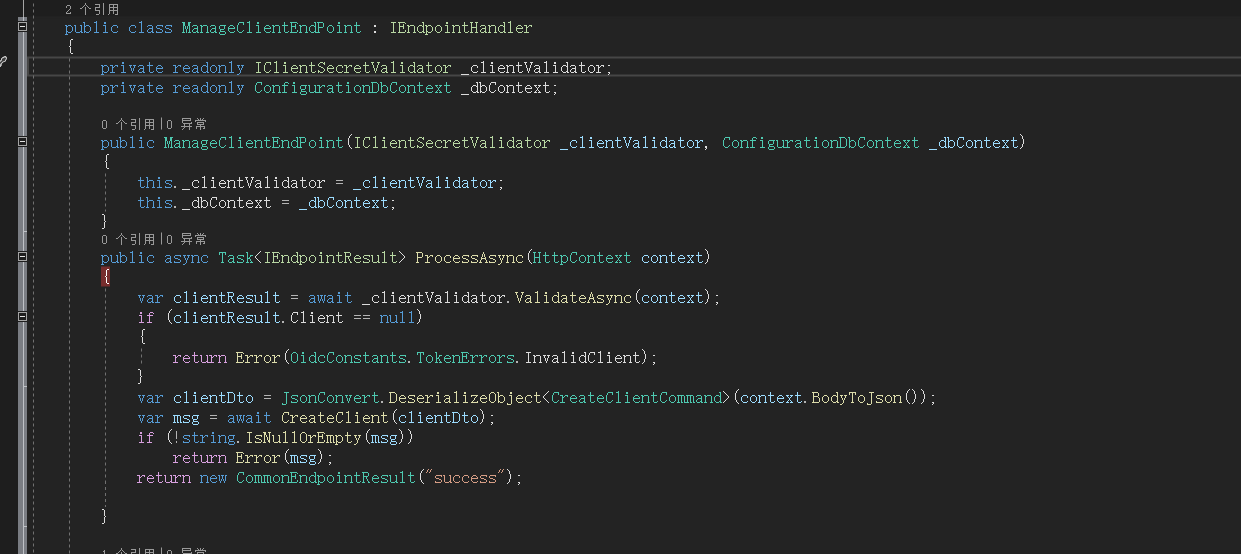
4.結尾
identityServer4要寫的東西實在太多,整體的把握理解還是有一定的複雜性的,我之前公司一個pass平臺專案,是基於認證中心,其他業務系統實現快速整合,我當時負責的就是授權資源、token管理,還有對IDP的授權型別、endpoint一些擴充套件,現在總結成部落格,寫的不是很細,希望對後來者帶來一些幫助和參考意義。
